Projects
Introduction
The Projects menu serves as the central hub for displaying all projects and functions as the default landing page when logging in via FX.
By default, users can only view projects created within the groups to which they belong. Administrators, however, have the privilege of accessing all available and private projects.
Clicking on a project name not only opens the project in the corresponding application (identified by the application icon next to the name) but also simultaneously locks the project for other users, depending on the configuration. Consequently, the project can only be opened by one user at a time, a status indicated by a blue lock symbol.
Alternatively, you can open a project using the Action Button by clicking "Open."
It is also possible to select multiple projects by holding down the shift or command key, enabling the execution of a dedicated action on the selected projects. Only actions applicable to all selected projects are displayed. For instance, if a combination of a locked and an unlocked project is selected simultaneously, the "unlock" action cannot be executed, as one of the two projects is not locked. This is denoted by the color of the action and a tooltip.

Overview
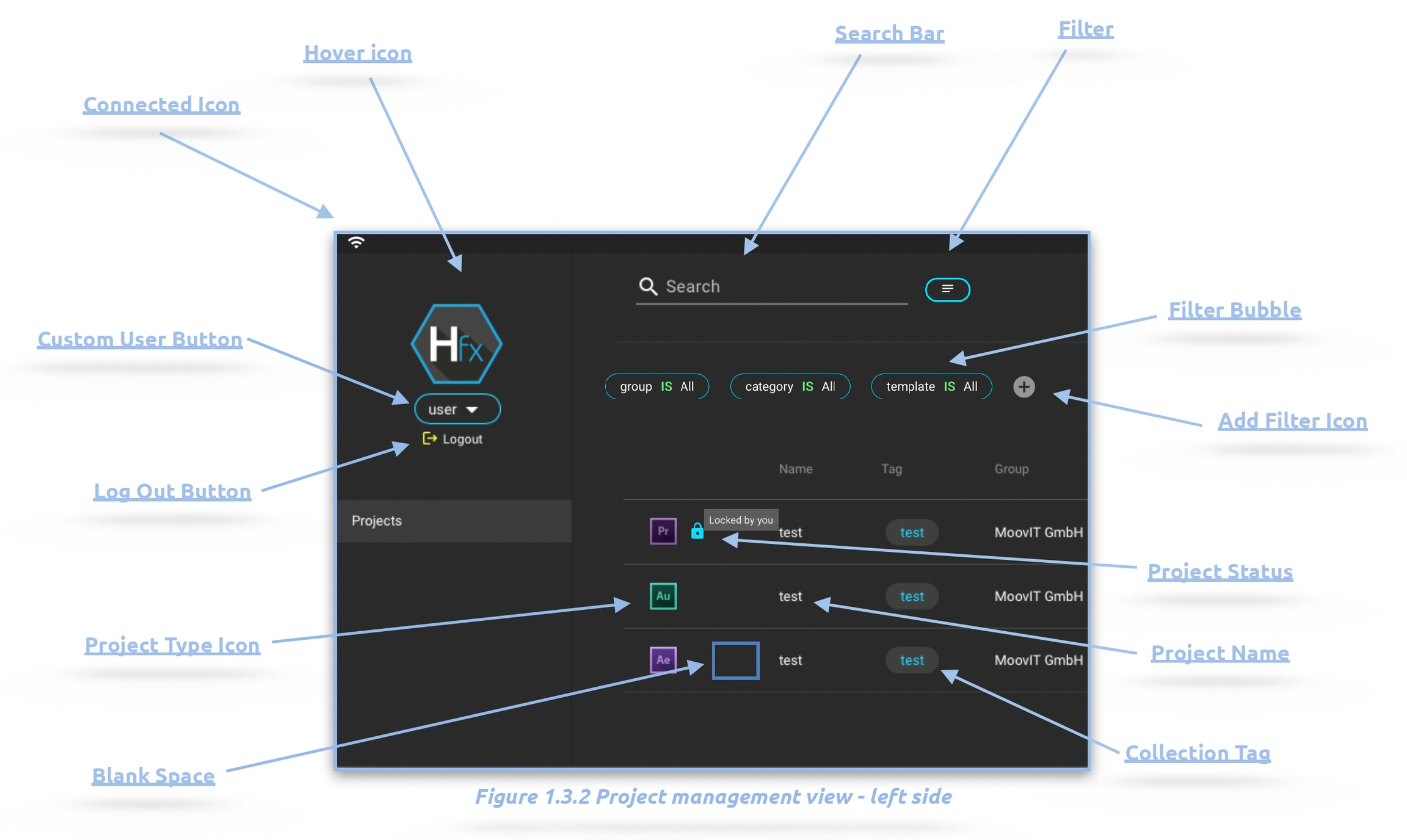
Connected Button
The connected icon indicates whether the client is currently running and connected to the system. If not, the icon turns red, displaying a red exclamation mark, and the entire web interface can only be used in a restricted mode. This restricted mode limits the functionality of the web interface but allows, for example, the use of the Web_Upload function in Cosmo.
It is possible to switch to the restricted web mode while the client is running by clicking on the white 'Wifi' icon located at the top left corner of the website.

Hover Icon
When the mouse pointer is moved over the product icon, the product icons of the other applications in Helmut4 will appear. This depends on the respective user settings and the acquired licenses.
Click on one of the appearing icons to switch to the respective application.

Search Bar
The search bar is designed for free-text searching. The search occurs in real-time as you input text, and it automatically generates a filter bubble. When a filter bubble is applied, the search is conducted within the existing list of projects, filtered by the newly set criteria.
The project overview allows you to search for various types of information, including Name, Tag, Group, Category, Template, Modified, Modified by, and Creator. Additionally, you can locate a project by entering its ID; however, it's essential to input the exact ID, which can be found in the hidden overlay.
If a filter bubble is activated, the search will automatically be conducted within the list generated by the filter.
Filter
The filter button enables users to effortlessly navigate through filter bubbles.
Users can create and save their customized sets of filters, assigning them dedicated names, such as "My Jobs," for easy recall when using a search filter.

Please note that filters are restricted to individual users, and there is no option to distribute filters globally to all users. Additionally, users have the ability to clear any currently applied filter bubbles, which are utilized to display specific projects, and delete previously saved user search filters.
Custom User Button
The purpose of the Custom_User trigger is to initiate a stream without any specific criteria. These streams are globally accessible to all users. The user will only see streams that have been enabled in this trigger.
However, they can only be viewed and executed when the Helmut4 client is connected to the system.
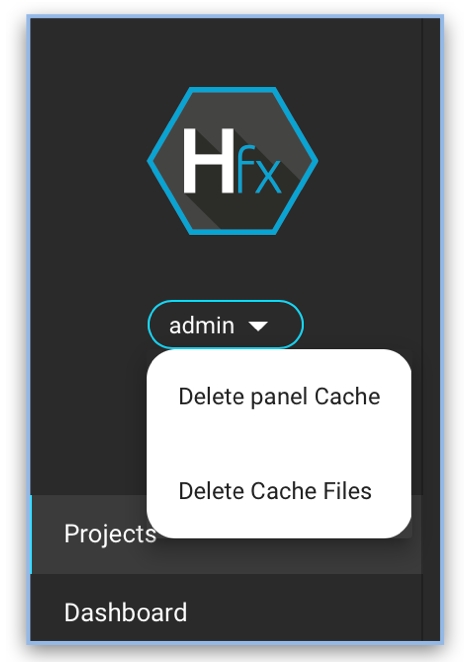
Logout Button
Clicking the logout button logs the user out of the server and redirects them directly to the login screen.
Any potential Disconnected trigger will be executed.
Filter Bubble
A filter bubble can be created by clicking on a metadata entry in the job overview or by clicking on a metadata entry in the hidden overlay. Clicking on the filter bubble itself opens a dialog for editing.
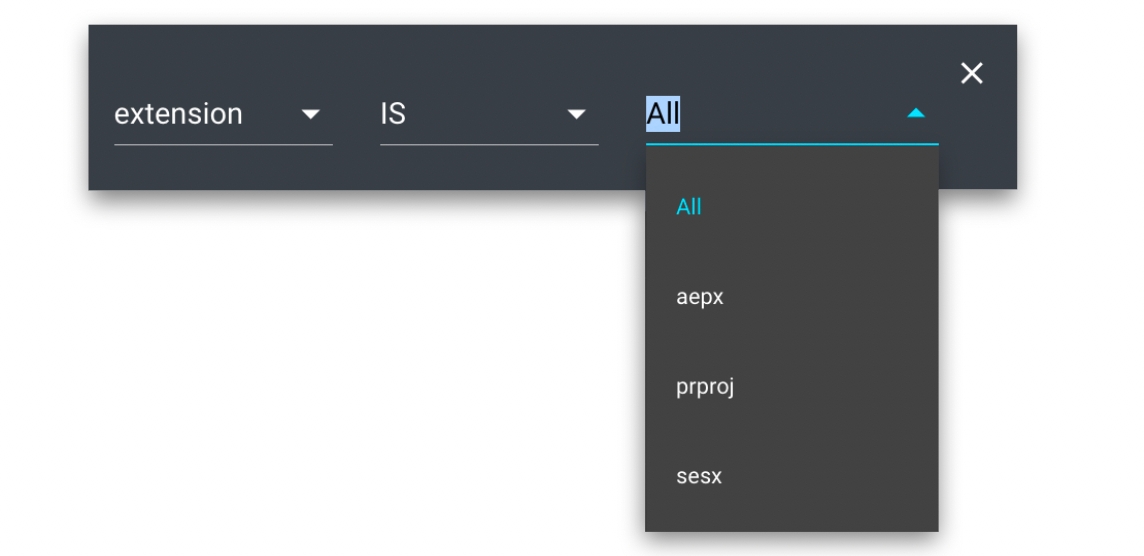
Filter bubbles enable searching for various information in the dashboard overview, including Name, Tag, Group, Category, Template, Modified, Modified by, Creator, and Metadata.
Add Filter Icon
The Edit filter button adds another filter bubble to the current selected filters.
Project Type Icon
The project type symbol indicates the respective project type. If the mouse is moved over the project type symbol, the file extension used for this project will be displayed. Products like Adobe After Effects support different file extensions that change the functionality of HelmutFX depending on their usage.
Project Status
Please refer to the Project Status for additional information.
Project Name
When you click on the project name, it will open the project using the associated application. If there is a corresponding workflow stored, the project will be locked for other users or marked as locked.
Please refer to the Project Status for additional information.
Blank Space / Overlay Menu
The empty space can be clicked to reveal the hidden overlay and clicked again to conceal it.
The overlay menu displays various project-related information such as the source, type, project metadata and more.

Custom Metadata
This displays the project metadata that has been added to the project during the project creation process through a Project Metadata Changer Action node.
Clicking on a prject metadata field sets a filter bubble in the Dashboard view.
Project ID
This will display the Project ID of the project.
Project Path
This entry displays the path to the location where the project file is stored. This entry can be concealed by adjusting the access rights at the user or group level.
Close Dialog Button:
This action will close the overlay window.
Project Tag
A project tag can be assigned during project creation, modified through the action button menu, or via the Project Set Tag Action node.
This tag serves to associate multiple projects as a collection and can be customized as needed, with a maximum length limit of 15 characters.

Header
The column headings are static, allowing you to filter them. However, it is not possible to rearrange or add extra columns to the project view.
The available column headings are as follows:
Name: The project's name.
Tag: The tag assigned during project creation or editing.
Group: The project's group affiliation.
Category: The project's category affiliation.
Template: The template used to create the project.
Modified: The date of the last modification.
Creator: The name of the project creator.
Add Project Button
Please refer to the Add Project for additional information.
Viewing (the number of available projects)
The view numbering indicates the quantity of projects presented in comparison to the total number of projects on the project page.
The maximum number of projects shown per page is 25 and can be adjusted by selecting from the options of 25, 50, 75, or 101 elements per page, accessible by clicking on the colored number text.
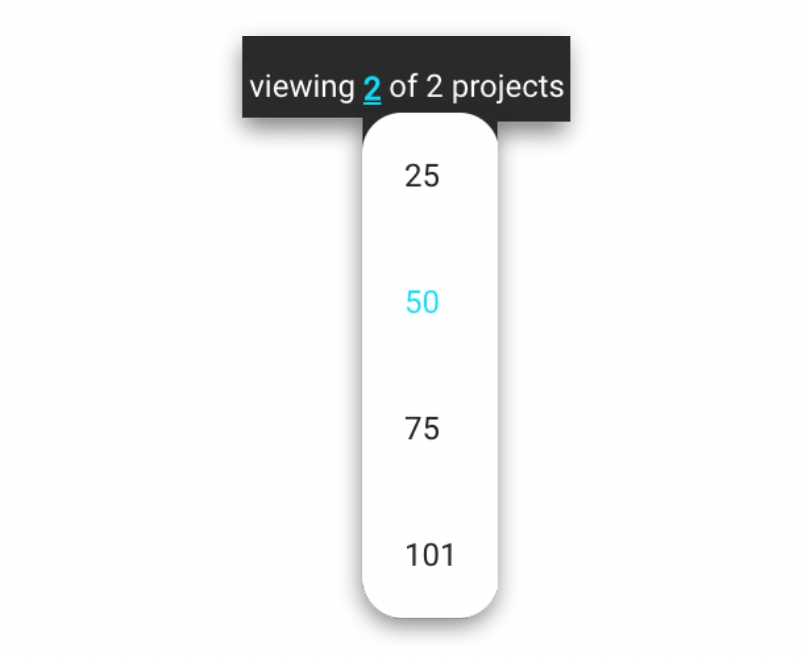
Refresh Button
If a filter has been applied, only the projects that were present at the time the filter was applied will be shown in the dashboard. When new pjects are added, they need to be loaded by using the Refresh button.
If the button is pressed while a filter is applied, only the projects that match the filter criteria will be reloaded.
Action Button Menu
he action button menu unveils a context menu presenting functions that can be executed on the selected project. This button remains visible even when clicking within the empty space of a project, allowing for the multi-selection of projects.
It's important to note that the availability of the following options is subject to any restrictions imposed by configured access rights:
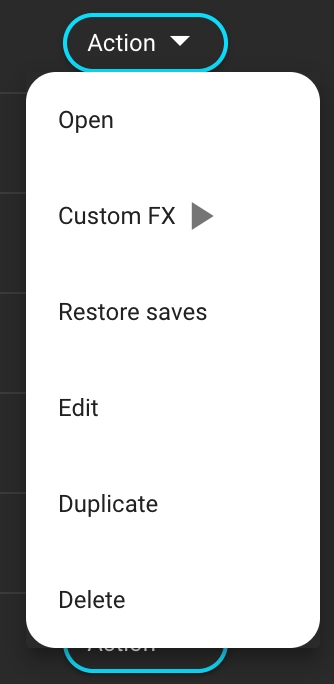
Open
Clicking the "Open" button, will open the project using the associated application. If there is a corresponding workflow stored, the project will be locked for other users or marked as locked.
Please refer to the Project Status for additional information.
Custom_FX
Hovering over the "Custom_FX" button will display all available Custom_FX streams for the dedicated group. Each Custom_FX stream must be assigned to a group.
Restore saves
When clicked, the "Restore Saves" button will display an overlay window, allowing the user to select and restore an autosave file for the given project. If there is already a backup of the project stored within the pre-defined "Saves" folder, the Saves folder must be located in the same directory as the project file. Clicking the "Restore" button within the dialog will trigger the "Restore_Save" action.

Edit
The button will trigger the "Edit_Project" action in the dedicated stream. The overlay window will enable you to change the values of related project metadata and set a new tag.
Duplicate
The button will trigger the "Edit_Project" action in the dedicated stream. The overlay menu, which will be displayed, is the same for the 'add new project' action. This menu allows you to modify existing metadata or choose another target group for the duplicated project.
Delete
The button will trigger the "Delete_Project" action in the dedicated stream. If the stream successfully completes, the corresponding project will be removed from the Helmut database.